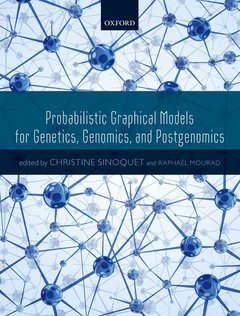Description
Probabilistic Graphical Models for Genetics, Genomics, and Postgenomics
Coordinator: Mourad Raphaël
Editor-in-Chief: Sinoquet Christine
Language: English
Subject for Probabilistic Graphical Models for Genetics, Genomics...:
Publication date: 09-2014
478 p. · 20.2x24.9 cm · Hardback
478 p. · 20.2x24.9 cm · Hardback
Description
/li>Biography
/li>
Nowadays bioinformaticians and geneticists are faced with myriad high-throughput data usually presenting the characteristics of uncertainty, high dimensionality and large complexity. These data will only allow insights into this wealth of so-called 'omics' data if represented by flexible and scalable models, prior to any further analysis. At the interface between statistics and machine learning, probabilistic graphical models (PGMs) represent a powerful formalism to discover complex networks of relations. These models are also amenable to incorporating a priori biological information. Network reconstruction from gene expression data represents perhaps the most emblematic area of research where PGMs have been successfully applied. However these models have also created renewed interest in genetics in the broad sense, in particular regarding association genetics, causality discovery, prediction of outcomes, detection of copy number variations, and epigenetics. This book provides an overview of the applications of PGMs to genetics, genomics and postgenomics to meet this increased interest. A salient feature of bioinformatics, interdisciplinarity, reaches its limit when an intricate cooperation between domain specialists is requested. Currently, few people are specialists in the design of advanced methods using probabilistic graphical models for postgenomics or genetics. This book deciphers such models so that their perceived difficulty no longer hinders their use and focuses on fifteen illustrations showing the mechanisms behind the models. Probabilistic Graphical Models for Genetics, Genomics and Postgenomics covers six main themes: (1) Gene network inference (2) Causality discovery (3) Association genetics (4) Epigenetics (5) Detection of copy number variations (6) Prediction of outcomes from high-dimensional genomic data. Written by leading international experts, this is a collection of the most advanced work at the crossroads of probabilistic graphical models and genetics, genomics, and postgenomics. The self-contained chapters provide an enlightened account of the pros and cons of applying these powerful techniques.
Christine Sinoquet is an Associate Professor in Computer Science at the University of Nantes, France, where she works in the area of bioinformatics and computational biology at the Computer Science Institute of Nantes-Atlantic. She holds a M.Sc. in Computer Science from the University of Rennes 1 and received her Ph.D. in Computer Science from this same institution. During her Ph.D. position at the Inria Centre of Rennes, she specialized in bioinformatics. She has initiated two Master degree programs in bioinformatics (University of Clermont, France, and Nantes). She currently serves as the Head of this second Master degree program since 2005. Her research activities have been focused on various topics including data correction prior to molecular phylogeny inference, motif discovery in biological sequences, comparative genomics and imputation of missing genotypic data. Her current research interests are algorithmic and machine learning aspects of complex data analysis in the biomedical field. Raphaël Mourad received his PhD from the University of Nantes in september 2011. His first postdoc (2011-2012) was at the Lang Li lab, Center for Computational Biology and Bioinformatics, Indiana University Purdue University of Indianapolis (IUPUI). He notably worked on the genome-wide analysis of chromatin interactions. His second postdoc (2012-2013) was at the Carole Ober Laboratory and Dan Nicolae Laboratory, Department of Human Genetics, University of Chicago. He worked on whole-genome sequencing data in asthma. As from november 2013, he started a third postdoc at the LIRMM, in Montpellier (France) which deals with the bioinformatics of HIV.
© 2024 LAVOISIER S.A.S.
These books may interest you

Population Genomics with R 188.53 €



